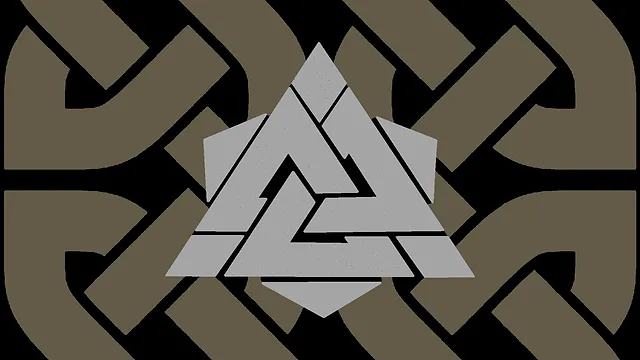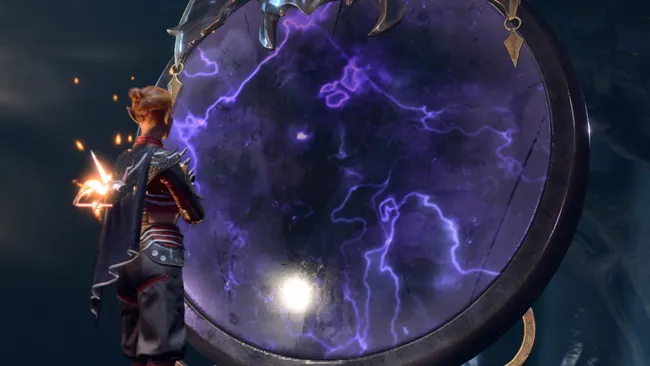The Valknut is one of the most iconic and enigmatic symbols in Norse mythology. Often depicted as three interlocking triangles, the symbol has captured the attention of historians, scholars, and enthusiasts of Norse culture alike. Found in various archaeological contexts, including rune stones and ancient carvings, the Valknut continues to provoke debate about its meaning and significance. Over the centuries, it has evolved from a symbol associated with the ancient Germanic and Norse tribes to a modern-day emblem that carries diverse interpretations, including connections to death, the afterlife, and Odin, the chief of the Norse gods.
Origins of the Valknut
The Valknut’s origins trace back to the Viking Age (793–1066 CE), a period in Northern Europe characterized by Norse exploration, trade, and conquest. The symbol appears most frequently in stone carvings and rune stones from this era, especially in regions that were influenced by Norse culture, such as Scandinavia, parts of the British Isles, and Iceland. Some of the most well-known instances of the Valknut can be found in the Stora Hammars stones on the island of Gotland, Sweden. These stones display elaborate carvings, including scenes of battle and sacrifice, with the Valknut often placed prominently within the designs.
The term “Valknut” is a modern word derived from Old Norse. It translates roughly to “knot of those slain in battle” or “knot of the fallen,” combining “valr” (slain warriors) and “knut” (knot). Despite the etymology, no single written record from the Viking Age explicitly names or describes the symbol as the “Valknut.” This lack of concrete documentation has left its precise meaning up to speculation, though the symbol’s frequent appearance in contexts related to death and sacrifice has led many scholars to associate it with themes of mortality and the afterlife.
Connection to Odin and the Afterlife
The Valknut is often linked to the god Odin, the Allfather in Norse mythology, known for his wisdom, warlike nature, and association with death and the afterlife. Odin is depicted as the leader of the Einherjar, warriors who died gloriously in battle and are chosen to live in Valhalla, awaiting Ragnarök (the end of the world). Since the Valknut frequently appears in scenes depicting warriors and sacrificial rites, many believe the symbol represents Odin’s power over life and death, as well as the fate of those who die in combat.
Additionally, some scholars suggest that the Valknut may symbolize the transition between life and death or the power to bind and unbind life. This aligns with Odin’s ability to shape the destinies of individuals, particularly warriors. The belief that those slain in battle would be taken to Valhalla or the fields of Fólkvangr (ruled by the goddess Freyja) further strengthens the association between the Valknut and the afterlife.
In particular, the Valknut is sometimes seen alongside the image of Sleipnir, Odin’s eight-legged horse, which is another significant symbol in Norse cosmology. Sleipnir could travel between the realms of the living and the dead, further underscoring the Valknut’s potential link to the otherworldly journeys associated with death.
Symbolism and Interpretations
The Valknut’s three interlocking triangles have led to a range of interpretations regarding its symbolism. While the original meaning may be lost to history, modern interpretations often explore the geometric and numerical significance of the number three in various mythological and philosophical contexts.
In Norse cosmology, the number three appears frequently, such as in the three roots of Yggdrasil (the World Tree), the three Norns (fates) who shape destiny, and the triad of realms (Asgard, Midgard, and Hel). The Valknut’s triangular form may reflect this recurring theme, symbolizing the interconnectedness of different aspects of existence: life, death, and the afterlife.
Other interpretations focus on the shape of the Valknut itself. The knot-like structure of the symbol suggests binding, possibly indicating Odin’s role in binding the souls of warriors to their fate or the interconnectedness of life and death. The infinite loops of the Valknut can also be viewed as a metaphor for the cyclical nature of existence, a theme that appears frequently in Norse mythology, where death is not the end but a transition to another phase of being.
The Valknut in Modern Culture
In modern times, the Valknut has experienced a resurgence in popularity, particularly among people who identify with Norse and Germanic pagan traditions. The symbol is often worn as jewelry, tattooed on the body, or displayed as a representation of one’s connection to Norse heritage or belief in the values of strength, honor, and the warrior spirit.
In particular, Heathenry (also known as Ásatrú), a modern revivalist movement based on ancient Norse paganism, has adopted the Valknut as a symbol of devotion to the gods, especially Odin. For many practitioners, the Valknut represents a spiritual bond with the Norse pantheon and an acknowledgment of the importance of living a courageous and honorable life, much like the warriors of old.
However, the Valknut has also been misappropriated by certain groups, particularly white supremacist organizations, who have used the symbol to promote their ideologies. It is important to note that while the Valknut may have been associated with ancient Norse warrior culture, there is no historical basis for linking it to modern racial ideologies. Many in the Heathen and broader Norse-revivalist communities have worked to reclaim the Valknut and other symbols from being co-opted by hate groups.
The Valknut in Popular Media
Beyond spiritual and cultural communities, the Valknut has also made its way into popular media, where it often appears in movies, television shows, video games, and literature that feature Norse mythology. The symbol’s mystique and connection to Viking culture make it a natural fit for narratives that emphasize the themes of fate, warriorhood, and the supernatural.
For example, the Valknut has appeared in series like Vikings and The Last Kingdom, both of which are set during the Viking Age and explore the intersection of Norse and Christian beliefs. Video games like Assassin’s Creed Valhalla and God of War also incorporate the symbol, drawing on its association with Odin and the broader themes of destiny and the afterlife.
Conclusion
The Valknut remains one of the most fascinating and powerful symbols from Norse mythology. Its origins and meaning, though shrouded in mystery, continue to spark interest among scholars and enthusiasts alike. While the symbol is commonly associated with death, the afterlife, and Odin, it has also come to represent the enduring legacy of Norse culture in modern times. Whether worn as an emblem of faith, heritage, or personal strength, the Valknut serves as a reminder of the complex and interconnected themes of life, death, and fate that pervade the mythologies of the ancient world.
As its cultural significance evolves, the Valknut’s place in both historical and contemporary contexts will continue to captivate those drawn to the myths and mysteries of the Viking Age.







